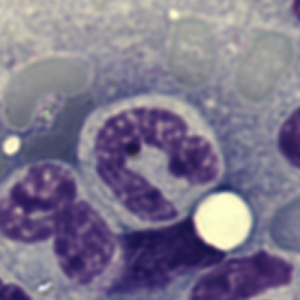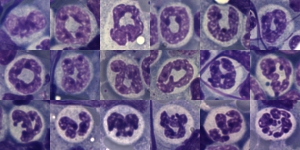The nuclear center might not be a simple concentric center. Why, maybe to allow for stretching and shape changing, particularly in leukocytes and migratory cells. Seems like a pretty smart approach to something that ‘can be round’ when it is physically convenient, but is more likely to be strung out pole to pole along with the cytoplasm, or independently of the cytoplasm as well (again, leukocytes, particularly the polymorphyn uclear leukocytes). This image of a bone marrow cell from mouse has an asymmetrical shape, which is easily found, in practically any microscopic field or any bone marrow smear. Maybe like a U, but more a V really as the chromatin densities are asymmetrical in this view and in many views. Even if one takes into consideration that this is still 3D (even after spreading) and that there might be two condensed chromatin areas where there appears to be just one in this picture, the U as a whole shows a bilateral symmetry maybe in two dimensions, but not in the third dimension. This begs the question what are the symmetries in x,y and z that unfold as leukocyte nuclei become lobular.
uclear leukocytes). This image of a bone marrow cell from mouse has an asymmetrical shape, which is easily found, in practically any microscopic field or any bone marrow smear. Maybe like a U, but more a V really as the chromatin densities are asymmetrical in this view and in many views. Even if one takes into consideration that this is still 3D (even after spreading) and that there might be two condensed chromatin areas where there appears to be just one in this picture, the U as a whole shows a bilateral symmetry maybe in two dimensions, but not in the third dimension. This begs the question what are the symmetries in x,y and z that unfold as leukocyte nuclei become lobular.
The following two images (composite markups from bone marrow smears from a single mouse. I should look up the treatment protocol, but i am pretty sure because of the number of images that it was receiving BaP. Not all nuclei are identified as belonging to polyymorphonuclear leukocytes, but what is common is two or four sets of condensations (obviously not all can be called the Barr body chromosome drumstick) but the pattern is clear 1] bilateral left to right x axis, bilateral in the Y axis (narrow bottom two definite condensation sites at the top, and a C shape (backwards) in the z axis shown in a group of progressing nuclear lobulation, and below that, lightened images lying under dots over areas of chromatin condensation … I tried to orient the wider separation of the sister condensation points toward the top.

